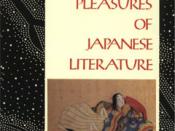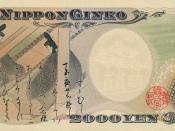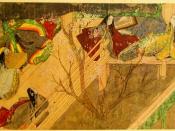Rich in sensitivity, quality and variety, Japanese literature ranks as one of the great literatures of the world. While some of its works are over 1,300 years old, they still capture us with their sensitivity to nature. Their writing is artfully worded and structured, and it has always been characterized by its lyrical beauty. In this essay, we will look at how Japanese literature has evolved over the years, beginning at the first complete works, and moving on through time to today's great Japanese writers.
Japanese literature began around the year 700. At this point in time, a great amount of Chinese influence could be seen in their work. The Japanese did not have a writing system of their own, and so they adopted Chinese characters to their own needs. This can be seen clearly in the most ancient complete work, the 'Kojiki' (Records of Ancient Matters), which was completed in 712.
Eight years later this was found again, in the second complete work produced by the Japanese, 'Nikon shoki' (Chronicles of Japan), which was completed eight years later.
The first great literary achievement of the Japanese was the 'Manyo-shu' (Collection of Myriad Leaves). This is an excellent anthology of more than 4,500 poems. It was compiled mostly by the courtier-poet Otomo no Yakamochi at some point in the late 700's, but it contained some poems that had been written a century or more ago. The majority of poems found in this collection are the tanka. These poems are 31-syllables, and, like most Japanese poetry, do not rhyme, but rather have a subtle rhythm within the structure of the poem. These poems usually dealt with friendship, love, and nature. There are also several longer poems, most of which praise the imperial family. (Keene, The Pleasures of Japanese Literature 11)
From 794 to 1185 the Japanese entered the Heian period, the first great period of Japanese literature. In this period, the greatest writers were usually women. During this period, the first work of Japanese fiction was written. It was entitled 'Taketori monogatari' (The tale of the Bamboo Cutter). This is a fairy tale that becomes a humorous satire on a group of gentlemen who have all fallen in love with the same women. All of them attempt to capture her love, but in the end her love is won by a suitor who they weren't even aware of. (Aston, History of Japanese Literature 76-80)
The next fictional story written is today considered to be the greatest fictional Japanese work ever. 'Genji monogatari' (The Tale of Genji), written in the early 1000's by a noblewoman by the name of Murasaki Shikibu deserves to be described as the first true novel, and one of the classics of literature. It focused on Prince Genji whose irresistible appeal was match only by his sensibility to beauty, be it in nature, the arts, or in a woman. There are hundreds of other characters throughout the story, all of whom are skillfully manipulated through all of the various twists within the plot.
Diaries and essays were also respected and well-written forms of literature during the Heian period. One of Murasaki's only rivals at the time was Sei Shonagon, who wrote the 'Makura no soshi' (Pillow Book, a notebook used to write down random thoughts). The first travel account in Japanese was written by a man named Ki no Tsurayuki, who entitled his book 'Tosa nikki' (Tosa Diary). Several more diaries were written by various women during this period, such as the 'Kagero nikki' (Ephemeral Diary), which records the unhappy emotional life of a young mother, as well as a diary by Murasaki Shikibu, the author of the Tale of Genji. (Bersihand, Japanese Literature 16)
In the late 1000's, romance became popular, and several historical romances were written. These included the 'Eiga monogatari' (Tale of Splendor), which focused on the Fujiwara house during the height of its power. Another well-written romance, the 'Okagami' (Great Mirror), was a romantic treatment of historic fact, and one of the first books of historical fiction.
During the 1100's, we can begin to see a shifting from the classical aristocratic style of the Heian Period to the more plain, more plebeian Medieval period, in which brief and pungent tales of goblins , miracles, and pious or coming happenings are told with a considerable mixture of Chinese vocabulary. (Keene, Japanese Literature 31, 32)
During the Medieval, or Kamakura, Period, the Japanese came under rule of the warrior class, and so the major literary focus of this period was the appearance of a new group of literature, called 'war tales. The first and most famous war tale was the gunki monogatari, which told of the struggle between the Heike and Genji clans that caused the loss of power by the aristocratic Fujiwara class and the takeover by the military shogunate.
One of the other famous war tales is the 'Heike monogatari', which focuses solely on the Heike's role in this struggle. This work is characterized by its somber tone, focusing on the defeat of various contending houses, as opposed to the victory of the opposing house. This was written by monks, and thus this novel likened to the melancholy Buddhist view that the beauties of the world are diminishing. This style had rarely been seen before the Medieval period, however, this particular tale began a trait in most Medieval tales with a deepening pessimism.
Some of the more famous essays that followed this tradition of pessimism were 'Hojoki' (Notes From a Ten-Foot Square Hut), and the 'Tsurezuregusa' (Grasses of Idleness), Both of which were written by female poets who had gone into conclusion for either religious or artistic reasons. However, we can begin to see a difference in style in the two poems. The 'Hojoki' delves into the memories of floods, fires, and famines, where the 'Tsurezuregusa' reveals a nostalgia for the courtly elegancies of former times, taking a somewhat less pessimistic look at the future.
During the 1300's, the first form of Japanese drama, the no drama, was developed and performed. It developed from primitive religious rituals involving song and dance, In the late 1300's, a playwright named Zeami Motokiyo shaped the no drama. It is still being performed today in the way that he originally performed it, as a combination of dancing and chanting with literary and poetic themes from the past.
In the 1500's and early 1600's, a middle class began to emerge within Japan. With the emergence of this middle class, came literary works that were focused on these middle classes, and their day-to-day lives. Many pieces of poetry dealt with humorous or sexual subjects within urban Japan. These works and the time they took place in (1603-1867) were known as the Tokugawa period.
One of the first new developments within the Tokugawa period was the haiku verse form within poems. This comic style of verse challenged the Tanka, with an easy to write rhythm, and 17 syllables. However, the haiku was changed from a humorous hobby into a serious art form by Matsuo Basho, during the late 1600's. He wrote a great amount of haiku, all according to strict rules, which described subjects in nature and contained references to various seasons. These poems take advantage of the seasons to suggest feelings and ideas, and require thought and input from the reader.
We can also see the development of two new types of dramas during the Tokugawa period: kabuki plays and puppet theater both flourished during the late 1600's and early 1700's. Kabuki plays are almost always melodramatic and feature colorful costuming and lively acting. While this style of play has been developed over time, it has always used the same main themes and traditions. (Keene, The Pleasures of Japanese Literature 115-120)
Puppet theater, which was first developed in the early 1700's, featured many dramatic masterpieces by Japan's greatest playwright, Chikamatsu Monzaemon. He popularized puppetry within Japan, and formed a respectable form of literature out of it, as opposed to the children's toy it has become in Europe and America. The poetic force of Monzaemon's scripts turned simple characters, such as shop clerks and prostitutes, into evolved and tragic figures. (Keene, Japanese Literature 57-66)
The Tokugawa came to an end in the late 1800's. At this point, the formation of new types of literature stopped for Japan, and its previous literature was developed and compiled. Western civilization also became to influence Japan, and thus some of Japan's traditional and mystical simplicity was lost.
The beautiful nature of Japanese literature has stayed as one of the primary forms of Japanese art since the beginning of Japanese civilization to today. It is rich in sensitivity and quality, and its many forms make it rich in variety as well. These factors, combined with an ability to reach a person on an emotional and spiritual level, have and will continue to make Japan worthy of being one of the world's great literatures.
Works Cited
Aston, W.G. A History of Japanese Literature. New York: D. Appleton and Company, 1925. (This book guided me through the history of Japanese literature, and gave me the basic outline for my paper.)
Bersihand, Roger. Japanese Literature. New York: Walker and Company, 1965. (I found this source to be helpful in giving me examples that allowed me to better understand the format for certain poetic structures, such as tanka and haiku.)
Keene, Donald. Japanese Literature: An Introduction For Western Readers. New York: Grove Press Inc., 1955. (Mr. Keene's introduction was informational in showing the various types of Japanese literature in an understandable, easy-to-read styles)
Keene, Donald. The Pleasures of Japanese Literature. New York: Columbia University Press, 1988. (This book gave me specific details on the various types of novels, and formats of poetry and theatre that could be found within Japan)



Good Study Guide
I think this is a good paper. I have a class on Asian culture and the final will have everything that was said in this paper. Its actually a good study guide.
0 out of 0 people found this comment useful.